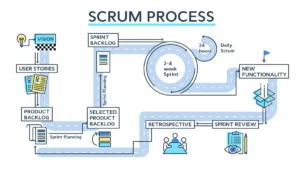In the realm of software development, the management of contractors plays a pivotal role in project success. These skilled professionals are key contributors to your projects, but their management requires finesse. Let’s delve into the world of managing contractors in the context of project management, emphasizing control and efficiency.
Have you ever been caught in a scenario where contractors in your software development project seemed to have a mind of their own? Perhaps they refused to follow the established development process, shied away from providing accurate estimates, or simply shrugged off accountability for their hours.
In this blog post, we’ll delve into the world of managing contractors in software development, using real-life challenges as valuable lessons. We’ll explore how critical it is to maintain control over projects while ensuring that every step aligns with your company’s objectives.
Setting Expectations and Ground Rules
The Development Process: More Than Just a Guideline
In a recent project, we encountered contractors who hesitated to follow our well-defined development process. They were reluctant to provide estimates, considering it a mere formality. Yet, the process isn’t just a guideline; it’s the roadmap to project success. Accurate estimation is the cornerstone upon which reliable project planning and execution are built. Ensuring that contractors understand and adhere to this is non-negotiable.
Accountability: The Clock is Ticking
Another challenge we faced was contractors shying away from being held accountable for their hours. Time tracking is more than a routine; it’s a critical part of efficient project management. Every minute counts, not just for the project’s progress but also for accurate billing. Emphasize the importance of meticulous time tracking, aligning hours with your tracking tools, and contractor invoices. Accountability ensures that both parties are on the same page, fostering trust in your working relationship.
Avoiding Lock-Ins and Maintaining Control
One crucial aspect of contractor management in software development is ensuring that you don’t end up in a bind. It’s not uncommon for contractors to introduce custom libraries, obscure tools, or gain server access that the company doesn’t have. This can create dependencies that might limit your future choices or leave you at a disadvantage.
To maintain control and avoid these potential lock-ins, make it a part of your contractor management strategy to:
- Access Parity: Ensure that your company has the same level of access and admin rights as contractors. Don’t let them hold the keys to critical aspects of your projects.
- Evaluate Tools and Libraries: Before allowing contractors to implement custom tools or libraries, assess their long-term implications. Will it create a lock-in scenario? Is there a more standard solution available?
- Documentation: Require thorough documentation for any custom solutions introduced by contractors. This documentation should be clear and accessible to your in-house team.
Estimating and Alignment
Permission First, Work Second
One of the most crucial lessons we learned was the significance of obtaining explicit permission before starting any work. Contractors may sometimes jump into tasks without waiting for the green light. This can lead to misalignment with project priorities and unexpected changes in scope. Establish a culture where work initiation is strictly permission-based. Contractors should refrain from starting new tasks or projects without prior approval, ensuring that all efforts align seamlessly with your company’s strategic objectives.
Maintaining Control
In our journey, we’ve come to appreciate that project control is paramount. While contractors bring valuable expertise to the table, they should work harmoniously with your team, not independently. In one instance, contractors took the reins, pushing the project off course. To maintain control, collaboration with contractors should be close-knit. You must provide regular updates, offer guidance, and have the authority to approve or disapprove any deviations from the established project scope and direction.
Quality Expectations and QA
Setting the Bar for Quality
Quality expectations should be crystal clear. Contractors must understand that their work needs to meet a specific standard. This includes adherence to coding guidelines, testing procedures, and the delivery of bug-free, reliable software. The goal is not just to complete tasks but to deliver a high-quality product that aligns with your company’s reputation and objectives.
Quality Assurance (QA)
Incorporating a robust Quality Assurance (QA) process is vital. Contractors should not consider their work finished until it passes through a rigorous QA phase. This ensures that the software meets the specified criteria and performs as expected. If any issues arise during QA, they should be addressed promptly without incurring additional costs. QA is a safeguard, not an added expense.
Tips for Success
- Documentation and Training: Comprehensive documentation outlining granted access, including privileges, is essential for reference. Ensure that contractors receive training on the proper usage of their access, promoting secure and efficient server management.
- Monitoring and Review: Regular audits of access permissions and activities are essential to maintain compliance with security standards and policies.
- Access Revocation Process: Establish a process for access revocation when it’s no longer required or when roles change within your organization.
- Escalation Process: Develop an escalation process to address any security concerns, breaches, or unauthorized activities promptly.
- Audit and Compliance: Regularly audit access permissions and activities to maintain compliance with security standards and policies.
- Transparent Communication: Open and clear lines of communication are paramount to ensure everyone understands budget constraints and project scopes.
- Budget Monitoring: Regularly monitor the software development budget against project progress, allowing for agile adjustments when needed.
- Scope Management: Ensure that software project scopes are well-defined and align with the available budget.
- Cost-Efficient Solutions: Encourage contractors to seek innovative, cost-effective ways to achieve software development goals without compromising quality.
In the world of software development, contractor management is an art of balance, especially when budgets are in play. We’ve mastered this art, ensuring that our software projects not only meet strategic objectives, but do so within financial boundaries. Contractors understand that expanding project scopes without approval isn’t just about control; it’s about being fiscally responsible. Join us in achieving software development success without breaking the bank through effective contractor management. After all, in this dynamic realm, it’s not just about reaching the destination; it’s about doing so efficiently and within budget.
Share Your Experiences
Mastering contractor management in software development can be challenging, but these real-life lessons have shown us the way. Now, we want to hear from you. Have you encountered similar challenges? How did you overcome them? Share your experiences and strategies in the comments below. Together, we can navigate the ever-evolving landscape of contractor management and software development.
Discover more from AJB Blog
Subscribe to get the latest posts sent to your email.






